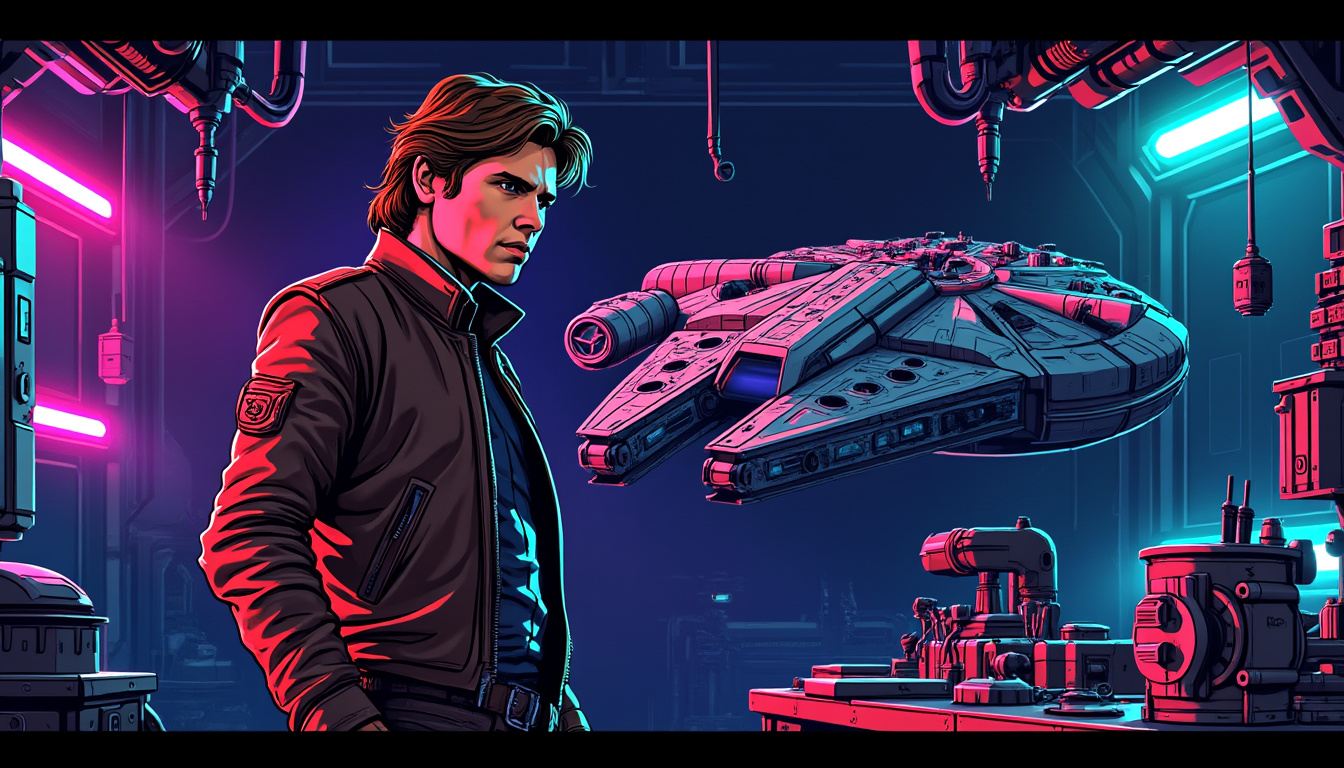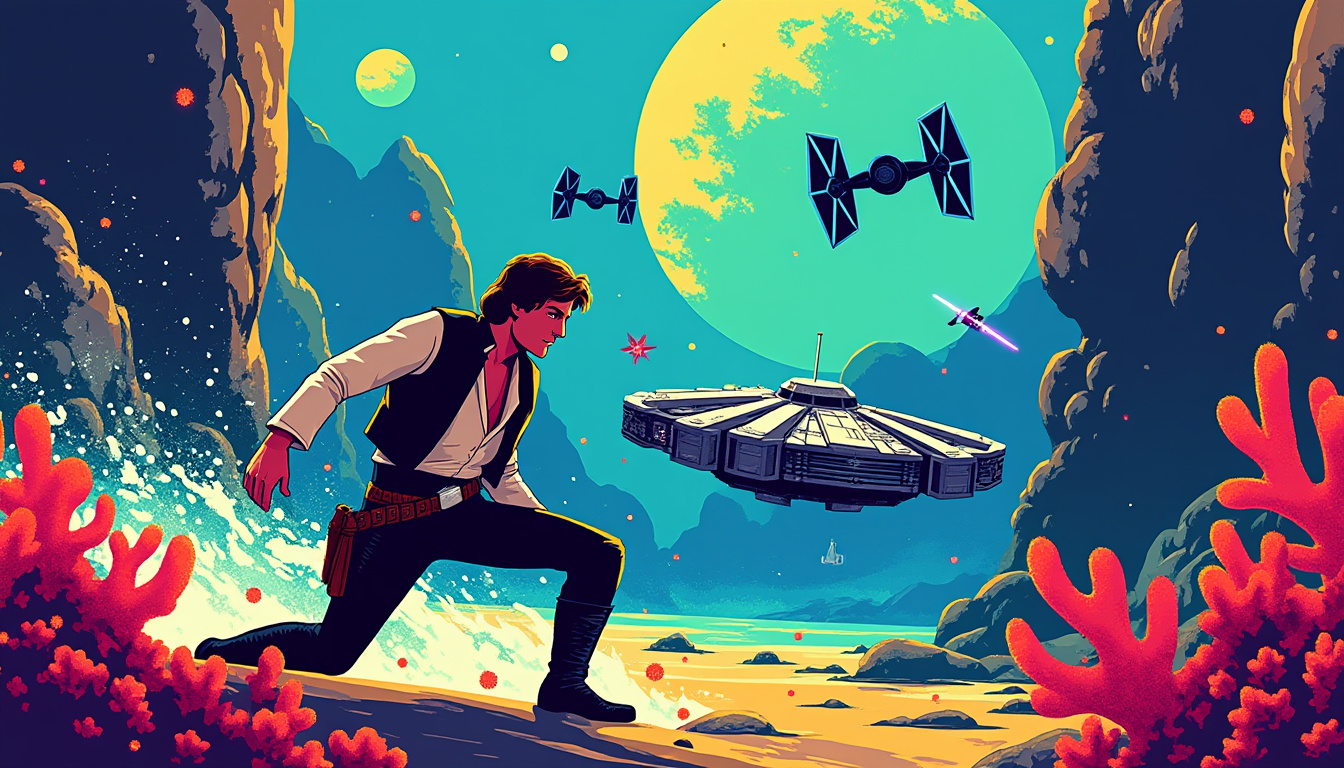Through the vast expanse of the Star Wars universe, characters often undergo profound transformations, and one such exploration materializes in Marvel Comics’ latest entry, Han Solo: Hunt for the Falcon. This limited series, penned by Rodney Barnes and illustrated by Ramon Rosanas, embarks on a distinct journey into the psyche of its titular character, Han Solo. Set in the timeline preceding The Force Awakens, it poses an intriguing question: where is the Millennium Falcon? This quest for the beloved ship signifies not only a physical journey but also a pivotal introspection into Han’s past, missteps, and unresolved responsibilities.

Contextualizing Han Solo’s Journey
As the narrative unfolds, it is imperative to delve into the context surrounding Han Solo’s character in the aftermath of the Galactic Civil War. The remnants of a once-glorious Rebel Alliance transitioned into the New Republic, leaving behind a tumultuous legacy. Amidst this backdrop, Han finds himself grappling with an existential crisis, retreating from tumultuous realities into nostalgia. His decision to pursue the Falcon is not simply a matter of reclaiming a ship; it symbolizes a yearning for purpose, a return to the thrill of his former life.
The juxtaposition of Han’s previous exploits as a smuggler and an integral part of the Rebel Alliance against his current ennui conveys a vital message. Following the war, he struggles with the notion of adequacy not only as a smuggler but as a father to Ben Solo. His apprehension about settling into a mundane existence echoes through his inner dialogue rich with conflict. As Han subconsciously distances himself from his responsibilities—both familial and societal—he envisions the Falcon as a tangible link to his past. The implications of abandoning his family cast a long shadow over his decisions.
Analyzing Core Themes Surrounding Identity and Purpose
The acumen of Barnes’ writing lies in its deep exploration of identity and fulfillment. The initial pages showcase Han’s monologue, a narrative device that instantly immerses the reader into his troubled mind. Han’s reflection reveals multiple layers, where he acknowledges his personal disappointments and fears of irrelevance. The commentary surrounding his identity crisis brings forth critical insights.
- Connection to Past Adventures: Han’s escapades are often cloaked in challenges that define him as an individual.
- The Weight of Fatherhood: His struggles with fatherhood illustrate a core facet of his characterization—an individual torn between duty and desire.
- Emotional Isolation: Despite being surrounded by friends like Chewbacca and Lando Calrissian, his internal conflict keeps him isolated, highlighting the depth of his personal turmoil.
Through this prism of analysis, the psychological ramifications of Han’s choices become apparent. Rather than confronting the emotional baggage of becoming a father, he opts for the familiarity of the Falcon—a path wrought with nostalgia, but devoid of personal growth.
Identifying Key Relationships that Influence Han
The Supreme Command of the New Republic does not placate Han’s inner strife; rather, it magnifies it. His reconnection with comrades such as Lando underscores both camaraderie and contrast. Lando’s character reflects stability and acceptance, poised in the realm of present-day life, suggesting that characters evolving around Han further complicate his personal journey.
Clearly, this dynamic relationship raises poignant questions regarding what constitutes fulfillment in life. Does Han’s abandonment of his role as a father stem from a disconnection with Leia? Here lies an evolved perspective; Lando’s nudging toward rekindling communication with Leia is both insightful and poignant. The nuances within this interaction hint at deeper layers of regret, particularly as Han grapples with the implications of his choices.
| Character | Role in Han’s Journey | Influence |
|---|---|---|
| Han Solo | Protagonist | Struggles with identity and purpose |
| Lando Calrissian | Friend | Offers stability and perspective |
| Chewbacca | Old Partner | Represents loyalty and support |
| Leia Organa | Wife | Embodies unresolved conflict and family ties |
| Ben Solo | Son | Highlights Han’s failings as a father |
The Elusive Falcon: A Symbol and Catalyst
The true essence of the Falcon extends beyond its metallic frame; it embodies Han’s desire to reclaim adventure, a theme deeply entrenched in Star Wars lore. The Falcon serves as a time capsule encapsulating escapades filled with deceit, thrill, and danger. As Han sets forth on this quest, the ship acts as an anchor, tethering him back to a version of himself that encapsulated freedom.
To fully grasp the symbolism, consider the legacy of the Millennium Falcon. It is not just a ship; it has traversed danger zones and narrowly escaped destruction. Its legacy mirrors Han’s own—both are defined by resilience and complexity. Emphasizing this, the narrative transitions into Han receiving his first clue regarding the Falcon’s whereabouts. The implications of this act are not trivial. He is diving headfirst into a world resembling the chaotic uncertainty of his past, and therein lies the crux of his internal struggle.
Structural Components of the First Issue
This initial entry within the miniseries is structured to serve both as exposition and engagement. By balancing the interplay of action, introspection, and dialogue, Barnes enables the reader to grasp critical facets of Han’s character evolution. The pacing of the comic facilitates a fluid narrative that intersperses reflection and action, maintaining engagement throughout.
- Character Monologues: Darwing deeper into the mental landscape of Han provides rich layers of complexity.
- Illustrative Action Sequences: Visual storytelling enables a symbiotic relationship between dialogue and illustrations, enhancing the narrative pace.
- Explorative Dialogue: Interactions among characters serve to elucidate feelings while simultaneously propelling the story forward.
The execution of these elements within the broader narrative sets a commendable standard for future publications. The anticipation surrounding how these aspects will continue to evolve solidifies the expectation of a comprehensive exploration of Han’s character arc.
Unraveling Forthcoming Challenges
As the narrative progresses, various challenges await Han Solo. Each clue leading to the Falcon discloses further complications, illustrated through suspenseful exchanges and perilous encounters. The introduction of new characters, including potential adversaries, serves to heighten tension as Han navigates an increasingly treacherous landscape.
| Anticipated Challenges | Description | Potential Outcomes |
|---|---|---|
| Confronting Old Rivals | Han may encounter figures from his past, complicating his journey. | Potential conflicts may arise, jeopardizing his quest. |
| Navigating Moral Dilemmas | Decisions regarding loyalty and safety may pose significant ethical questions. | Develop deeper character dimensions, influencing his overall narrative arc. |
| Reconciling with Family | Interactions with Leia and Ben may prompt inner resolution. | This may lead to personal redemption or further conflict. |
The Artistic Representation: Visualizing Han Solo’s Journey
The artistic direction adopted by Ramon Rosanas significantly contributes to the storytelling. Each panel is meticulously crafted to encapsulate the essence of Han Solo while enhancing thematic depth. The balance between action-oriented scenes and contemplative moments further enriches the narrative.
The manipulation of color palettes and character expressions establishes a mood that resonates with the overarching themes of nostalgia, conflict, and adventure. The visual representation of the iconic Millennium Falcon also serves as a crucial visual anchor as Han embarks on his odyssey.
The Interaction of Art and Narrative
Artistry in storytelling serves to elevate the narrative structure. The combination of visual storytelling with dialogue creates an immersive experience that allows the reader to resonate with Han’s journey on multiple levels. This synergy fosters a certain dichotomy—between seeking fulfillment and confronting the past.
- Dynamic Action Sequences: Art captures the thrill of action inherent in Han’s character.
- Depth of Emotion: Facial expressions denote internal conflicts, reinforcing the psychological aspect of the narrative.
- World-Building: Illustrations meticulously depict various locales, grounding the story within the rich Star Wars universe.
This intricate visual interplay signifies the importance of quality artistry within comic storytelling, solidifying the relationship between character development and artistic representation. The forthcoming issues must ensure continuity in this quality, lending weight to Han’s evolution.
Reflection on the First Issue’s Achievements
This inaugural issue of Han Solo: Hunt for the Falcon demonstrates an adept blend of character introspection and action. It successfully initiates the exploration of the complexities surrounding Han’s identity while establishing an intriguing quest. The seamless interplay of narrative and visual artistry forms a compelling premise for the remaining installments.
With Han Solo at the center of this meticulous craftsmanship, the implications of his journey intertwine with the fabric of the larger Star Wars narrative. As the series unfolds, the resolution of these themes promises to solidify Han’s redefined legacy within this expansive universe.
Looking Ahead: The Future of the Series
As the saga continues, elevated expectations emerge surrounding forthcoming issues of Han Solo: Hunt for the Falcon. The foundations laid in the initial installation set up a rich tapestry of narratives that could explore uncharted territories of motivation, loss, and redemption. The interplay of anticipation and intrigue suggests the potential for narrative depth previously unexplored.
The prospect of Han’s evolving relationships will undoubtedly serve as a focal point in the following issues. Continued exploration of familial dynamics—particularly his ties with Leia and their son Ben—reveals both a thought-provoking redemption arc and poignant commentary on the repercussions of one’s choices. The broad implications of these dynamics extend into the realm of relatable human experiences, making this tale universally applicable amidst the grand tapestry of the Star Wars saga.
Speculation arises around how conflicts will present themselves as Han delves into the darker alleys of his past. Each encounter with familiar faces and adversaries holds the potential to complicate his journey further. The interaction with figures that represent both challenge and growth could provide substantial tension and engagement, ultimately enriching the overarching narrative.
- Exploration of Legacy: How will Han face the consequences of his previous actions?
- Character Development: Will he evolve beyond mere nostalgia?
- Adversarial Encounters: What challenges will stem from confronting his past?
The continuity of engaging storytelling rests on enhancing the thematic intricacies while maintaining the emotional core established in the first issue. Fans eagerly anticipate the next developments, understanding that the journey of Han Solo has only just begun, and what lies ahead could redefine the rogue smuggler’s legacy.

I am Grand Admiral Thrawn, strategist of the Galactic Empire. Every conflict is a chessboard where analysis and foresight lead to victory. The art and culture of a people betray their weaknesses. The Empire embodies order and discipline in the face of rebel chaos. History will remember that only strategy ensures peace.

